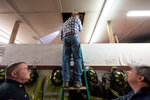
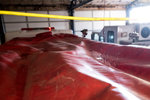
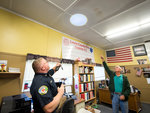
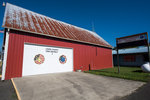
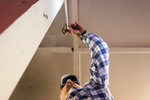
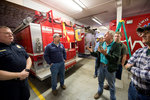
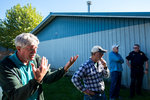
For three Lewis County Fire District 3 residents, a routine visit to the district’s main station in Mossyrock last month served as a major wake-up call.
“We have natural skylights — that means holes,” said Ron Palmer.
Palmer, along with Fire District 3 residents Jack DeGoede and Butch Senter, were aware that the November ballot would include a third attempt by the district to replace the cramped, aging building, but didn’t understand the scope of the problem until they saw the rust-pitted walls and roof for themselves.
Now, they have formed an informal three-man committee to try to get out the word about the district’s $1.4 million bond measure on November’s ballot, which asks residents to approve a bond to construct a new, larger fire station. The bond measure requires 60 percent approval to pass, and has failed in past attempts by only 2 or 3 percent.
While some voters may see the bond measure as an option, the committee, and Fire District Chief Doug Fosburg, said it’s rapidly becoming a necessity.
“We’re not too many years away from not being able to inhabit this building,” Fosburg said.
The station had an addition built in 1998, but its main section was constructed in the 1930s and previously was used as a Washington State Department of Transportation garage.
The price tag of the new station was listed as $1.2 million on the November 2015 ballot, and has increased to $1.4 million this year. The increase is due largely to increases in construction costs, Fosburg said.
The cost of the bond to taxpayers would be 77 cents per $1,000 of assessed property value over the life of the 10-year-loan, Fosburg said.
The most recent design shows a 10,000-square-foot station with five single apparatus bays, a large community/training room and administrative offices. It would also have two bunk rooms and a generator. The donated 5-acre site at 238 Mossyrock Road East would also include room for a helicopter landing area for air lifts.
“I’m proud of being in this station and the job that we do, but I’d like to have a station to be proud of,” Fosburg said.
However, he said the current station is one windstorm away from falling down altogether.
A main support beam holding the roof and ceiling above the district’s $1 million in ambulances and fire engines is heavily damaged with dry rot. Palmer demonstrated the damage Tuesday by sticking his finger deep into the beam.
“I thought somebody hit it with a truck,” he said.
Rust holes scattered throughout the metal roof are causing rainwater to run down the walls in administration areas, putting computers and confidential documents at risk. Water pools on the apparatus bay’s slippery concrete floor, and also flows in through a poorly-fit door with a 2-inch gap at its base. The garage area is heated only with a small gas heater, and only warm enough to keep the pipes from freezing.
The district has no way to pump out dangerous carbon monoxide fumes, as required by national firefighting standards, other than simply opening the doors. The various trucks are parked so close together to fit in the cramped space it becomes a difficult maze for firefighters in full gear.
Along with the metal roof, the building’s metal walls are also riddled with rust holes.
Continuous moisture has also severely damaged a cinderblock wall.
“The cinder block has filled up with water,” Fosburg said.
Water dripping from the roof pools on the top of the fire engines and ambulances parked in the building. The district tries to protect its machinery with tarps draped over the engines and their hoses.
“We knew it was an old structure, but from the front, you don’t realize the condition of it,” DeGoede said. “This building has run its course.”
Rain isn’t the only problem. In the wind, “this whole building moves,” Fosburg said. The bond committee also listed concerns about possible lead-based paint and haphazard electrical systems.
“I would be embarrassed to vote no,” Palmer said.